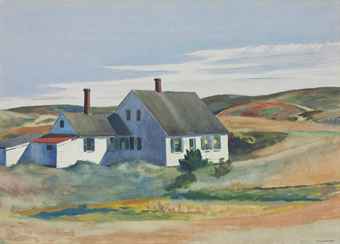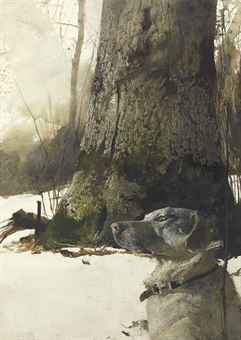On 23 May, Christie’s will present the Spring sale of American Art, with modern masters Edward Hopper, Georgia O’Keeffe, Milton Avery and others, highlighting the event. The sale will feature works from prominent private collections including Three Generations of Wyeth: The Collection of Eric and Cynthia Sambol, which is comprised of a stunning group of 13 pieces by N.C., Andrew, and Jamie Wyeth, and a selection of works from the Collection of Andy Williams. In all, 140 exceptional works from a diverse group of artistic movements in American Art across the 19th and 20th centuries will be offered, including Modernism, Impressionism, and Illustration.
Leading the sale is Edward Hopper’s magnificent, large-scale painting Blackwell’s Island (estimate: $15,000,000-20,000,000). The work, which has never been offered at auction, has been exhibited at renowned institutions, such as The Museum of Modern Art, The Whitney Museum of American Art, the Museum of Fine Arts in Boston, and Pittsburgh’s Carnegie Institute. More recently, Blackwell’s Island was included in the first major retrospective of the artist’s work at the Grand Palais in Paris from October 2012 through February 2013. An impressive five feet wide, the work was painted in 1928 and depicts what is now known as Roosevelt Island. A native of Nyack, Edward Hopper was drawn to the New York’s East River and used the banks and bridges as his subject several times between 1911 and 1935.
Originally known as Hog Island and today known as Roosevelt Island, Blackwell’s Island has a rather notorious history. Its varied architecture and isolation is likely what attracted Hopper to the locale.
Elizabeth Sterling, Head of American Art at Christie’s in New York said: “Painted in 1928, a watershed year for Hopper both creatively and critically, Blackwell’s Island is a visually striking painting that embodies the haunting aesthetic and tension that characterize the artist’s best work. Unlike his contemporaries who were drawn to the vibrant energy of a bustling metropolis, Hopper focused on the quiet aspects of the city. Even his choice of architecture, as seen in Blackwell’s Island, was of an earlier age than the new skyscrapers such as the Chrysler Building, which captivated his peers. Hopper’s unique aesthetic distinguished him from his contemporaries and makes him one of the most important artists of the 20th century.”
Blackwell’s Island acts much as a film still, a hallmark of Hopper’s most celebrated works, creating a suspended narrative that continually engages the viewer’s psyche and imagination as one tries to reconcile oneself with a scene that eludes resolution. Hopper’s dramatic effects of light and shadow on buildings silhouetted against a band of largely cloudless sky add to the pervasive and haunting silence of the painting. The swirling band of cobalt blue water acts as a physical barrier between the viewer and the subject, symbolizing a psychological distance and creating a sense of unease. The river also allowed Hopper to introduce an element of motion into an oeuvre that is primarily dominated by stillness, the flowing currents contrasting with the static architecture.

Also by Edward Hopper is Kelly Jenness House (estimate: $2,000,000-3,000,000), one of the eight watercolors the artist executed in 1932. Painted in Hopper’s signature style, the work presents a view of a Cape Cod House as one would glimpse the scene from the window of a passing car. The sense of distance and detachment in Kelly Jenness House places the painting among Hopper’s finest works.

My Backyard by Georgia O’Keeffe estimate: $1,000,000-1,500,000) is a wonderful example of the New Mexican landscapes with which the artist has become so closely associated and is being sold to benefit the Foundation for Community Empowerment in Dallas Texas. The work, which was painted in 1943 when O’Keeffe was frequently traveling to the Southwest, emphasizes the monumental and spiritual qualities of the region. As with her finest works, the strength of My Backyard lies in its careful balance of realism and abstraction, its intricate layering of objective and subjective meaning, and its wonderful synthesis of form and color.

Norry Seavey Andrew Wyeth 1938
Three Generations of Wyeth: The Collection of Eric and Cynthia Sambol will also be offered in the sale on May 23. Comprised of thirteen works by N.C., Andrew, and Jamie Wyeth, the collection includes important and notable works from three generations of arguably the most remarkable American art family dynasty of our time. Six works by Andrew Wyeth will be offered in the Sambols’ collection.

Rocky Hill embodies the hallmarks that have made him one of the most enduring figures in American Art. Andrew often worked in series, becoming devoted to particular locations and the subjects, thereby allowing him to lend sincerity to his style without sentimentality. The subject of Rocky Hill is his faithful dog Nell, who Wyeth often revisited as a subject. The work not only embodies a sense of loneliness, but also pays tribute to the passage of time and the people and places that inhabit the artist’s daily life in Maine and Pennsylvania. The permanence of the forest and terrain juxtaposed with the living creature, standing at attention, make Rocky Hill among Andrew Wyeth’s most profound representations of the theme of the passage of time.
Six works from the Andy Williams’ collection will be included in the sale, including two important paintings by Milton Avery,

The Musicians (estimate: $400,000-600,000)

and Pale Flower (estimate: $250,000-350,000). The success of Milton Avery's art lies in his ability to modernize a familiar domestic scene through his carefully orchestrated arrangement of color and pattern. He translates his subject matter into a unique lexicon of shapes and forms that fit together to create a cohesive composition. Painted in 1949, The Musicians was executed during the most critical period of Milton Avery's career, when he incorporated the simplified, blocked forms for which he became known. In addition to their broad popular appeal, Avery's bold, abstracted shapes exerted an important influence on Post-War American painters, especially Mark Rothko and Adolph Gottlieb. His work also reflects the same painterly concerns that consumed the pioneers of French modernism. Like Matisse, Dufy, and Picasso, Avery arranges planes of saturated color while retaining the two-dimensional surface of the canvas.

The sale will also offer a fantastic array of Impressionist works, including Childe Hassam’s In a French Garden (estimate: $800,000-1,200,000), which demonstrates the artist’s abilities at the height of his career. The work features a favorite theme of the artist, women and flowers, as he depicts a model, likely Mrs. Hassam, reading a newspaper in a lush garden. Hassam painted In a French Garden, at the summer residence of his friend Ernest Blumenthal in the Parisian suburb of Villiers-le-bel. The artist found the grounds to be wonderfully inspiring, completing several other museum-quality works there, including

Gathering Flowers in a French Garden
++Geraniums.jpg)
and Geraniums.
The vibrant palette and varied brushwork of In a French Garden demonstrate Hassam’s developing Impressionist technique and contribute to the brilliant vision of a peaceful domestic moment.
Also among the sale’s Impressionist highlights are The Palm Leaf Fan by Thomas Wilmer Dewing (estimate: $800,000-1,200,000), a beautiful composition that pays homage to the works of Whistler and Vermeer, and July Afternoon by Guy Rose (estimate: $300,000-500,000), often considered the most prominent Californian Impressionist painter.

A quintessential oil on canvas by Norman Rockwell is just one of the many illustrations that will be offered on May 23. Starstruck (estimate: $800,000-1,200,000) was painted for the September 22, 1934 cover of The Saturday Evening Post and depicts a young boy fawning over Hollywood’s leading ladies of the day. Distracted by the beautiful movie stars, the boy has cast aside his childish pursuits of baseball and playtime with his faithful sidekick. The fact that both the boy and his dog are pining for the attention of an unwitting subject underscore the scene’s charm.